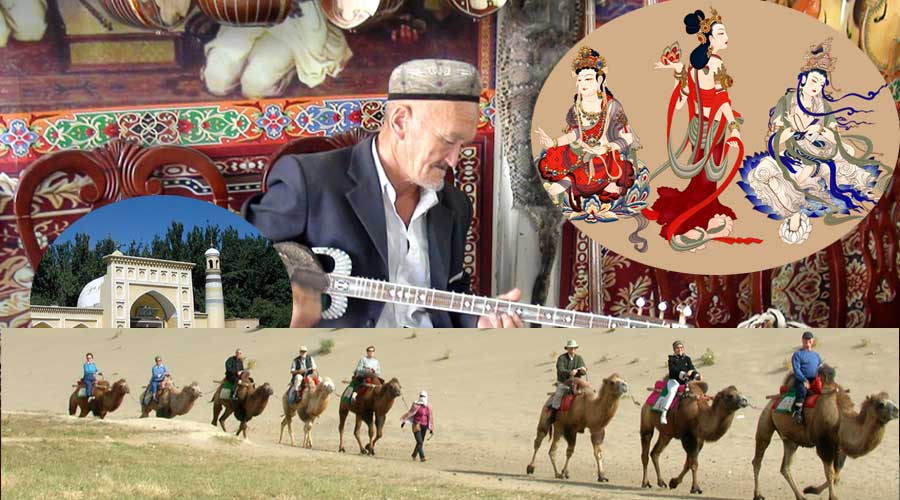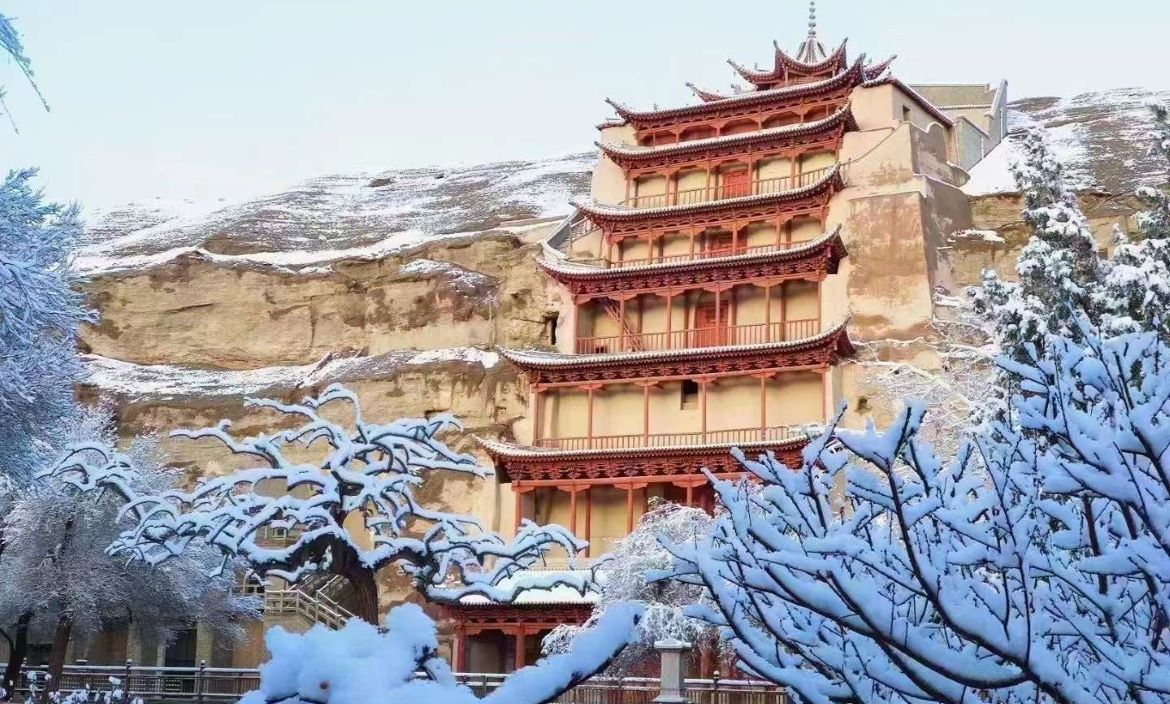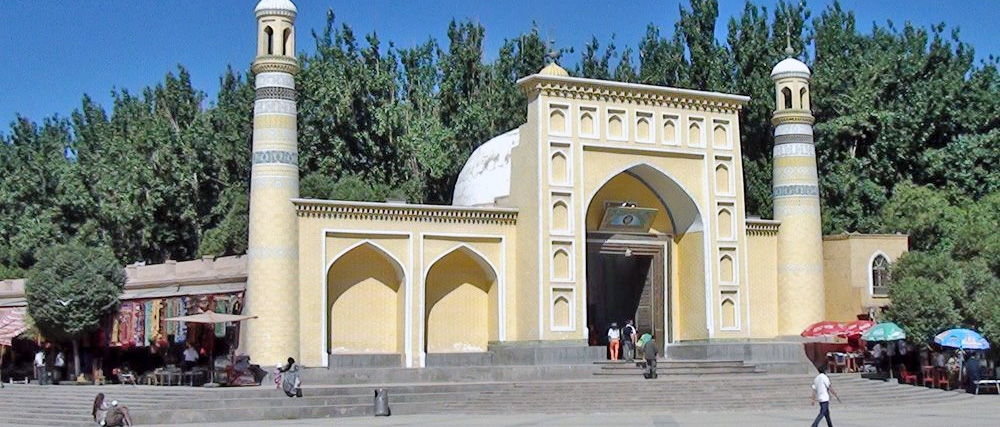
Beijing – Xi’an – Dunhuang – Turpan – Urumqi – Kashgar – Shanghai
The network of overland trade routes collectively known as the Silk Road, a term coined by German geographer Ferdinand von Richthofen in 1877, was established during the Han Dynasty (206 BCE-220 CE) of China. It stretches from the eastern terminus of Chang’an (present-day Xi’an) all the way to the Mediterranean Sea. On this exotic Silk Road China tour we retrace the footsteps of Marco Polo to explore the glorious past of the fabled Silk Road. Trip highlights include the Great Wall, the Terracotta Army, Mogao Grottos and the scenic drive from Kashgar to Karakul Lake on winding Karakoram Highway whose route overlaps one of the many paths of the Silk Road.
This is a physically demanding tour venturing into locations as high as 3,645m (12,000 feet) above sea level. Travellers prone to altitude sickness should take precaution.
Important Features
- Small group size – average 15, maximum 20
- Expert local guides hand-picked by owners of Laurus Travel
- No forced shopping stops
- Free Wi-Fi in all hotels
- Quality meals at non-tourist restaurants
- Unlimited supply of bottled water during group activities
- Great Wall visit at Mutianyu with cable car
Meal Code: B = breakfast / L = lunch / D = dinner
Day 1/Thu: Departing for Beijing
Your Silk Road China tour begins with your international flight to China today. You’ll lose a day upon crossing the International Date Line.
Day 3/Sat: Beijing (B/L/D)
The capital of China, Beijing is a world-class cultural and educational centre with a population of 21.9 million (2020), ranking it China’s second largest city behind Shanghai. Beijing is renowned for its opulent palaces, temples, and huge stone walls and gates – treasures that make it the most popular tourist city in China by the number of visitors it receives every year.
We begin today with a visit to the Forbidden City. Officially known as the Palace Museum, the Forbidden City was the place where the emperors of the Ming (1368-1644) and Qing (1644-1912) dynasties lived and carried out their administration. Construction of the Forbidden City took 14 years (1406-1420) to complete. The complex consists of 980 buildings and covers 72 hectares or 180 acres. It exemplifies traditional Chinese palatial architecture and has influenced cultural and architectural developments in East Asia and elsewhere. Though the Qing Dynasty was overthrown in 1912, the royal family was allowed to continue to live in the Forbidden City till 1924, when the last emperor, Pu Yi, was driven out of the imperial palace. One year later the Forbidden City was turned into a museum. Declared a World Heritage Site by UNESCO in 1987, this is the largest collection of preserved ancient wooden structures in the world.
Next up is Tian’anmen Square. Located in the heart of Beijing, the square measures 880 metres from north to south and 500 meters from east to west. Said to be the largest public plaza in the world, Tian’anmen Square has the capacity to hold one million people. The imposing Tian’anmen Tower sits at the north end of the square while the Monument to the People’s Heroes dominates the centre. The square is flanked by The Great Hall of the People (west) and the National Museum (east). Chairman Mao’s Mausoleum and Qianmen (Front Gate) are located in the south of the square. One of the top 16 tourist attractions in Beijing, Tian’anmen Square is also the witness of the Chinese people’s great struggles for democracy and personal freedom since 1919.
Afternoon sightseeing takes place at the Temple of Heaven, another UNESCO World Heritage Site. Situated in southeastern Beijing, the Temple of Heaven is China’s largest extant sacrificial temple where, during the Ming and Qing Dynasties, the emperors conducted the elaborate and most exalted sacrifices addressed to “the Supreme Ruler of the Universe.” Construction of the temple started in 1406, during the reign of the Ming Emperor Yongle, and took 14 years to complete. The temple was expanded under the Qing emperors Qianlong (1736-1796) and Jiaqing (1796-1820). Occupying 2.73 square kilometres (roughly 1,700 by 1,600 metres), the area of the Temple of Heaven is more than twice that of the Forbidden City.
The famous Hongqiao Pearl Market, the largest pearl market in the world, is right across the street from the Temple of Heaven. Recommended by numerous guidebooks for freshwater pearls, Hongqiao teems with domestic and international shoppers. If you are interested, please ask the guide to drop you off there. However, you’ll need to get back to the hotel by taxi, which costs about 8 US dollars.
Today we enjoy a delicious dinner at a popular Peking Roast Duck restaurant. Peking Roast Duck is a famous Beijing dish prized for the thin and crispy skin with authentic versions serving mostly the skin and little meat, sliced in front of the diners. The meat is wrapped in a thin layer of pancake (Chinese tortilla) together with shredded scallion, cucumber, and a sweet and salty sauce made of wheat flour. Condiments may also include pickled garlic and white sugar.
Day 4/Sun: Beijing (B/L)
After an early breakfast we embark on a full-day excursion to the legendary Great Wall at Mutianyu, 75 km northeast of the city.
Zigzagging over 6,000 kilometres from east to west along the undulating mountains, the Great Wall was built to hold off tribal invaders from the north. As history shows, the Wall failed the Chinese rulers miserably, especially in the case of Kublai Khan who and his men swept across China from the Mongolian steppe, thus the beginning of the Yuan Dynasty (1279-1368).
Construction of the earliest sections of the Wall started in the 7th century BCE. A major renovation started with the founding of the Ming Dynasty in 1368 and took 200 years to complete. The wall we see today in Beijing is almost exactly the result of this effort.
Day 5/Mon: Beijing – Xi’an (B/L/D)
We begin our sightseeing today with a visit to a traditional hutong neighbourhood. Hutong refers to an ancient alleyway with siheyuan or ”4-sided courtyard house” on both sides. The name hutong dates back to the Yuan Dynasty (1279 – 1368 CE). According to some experts, the word originated from the Mongolian language, in which it is pronounced as hottog and means “well.” In ancient times, people tended to gather and live around wells. So the original meaning of hutong should be “a place where people live around”.
Next on our schedule is the Summer Palace, a well preserved UNESCO World Cultural Heritage Site. The imperial resort was first named Garden of Clear Ripples, which was burnt down by the allied forces of Great Britain and France in 1860 at the end of the Second Opium War (referred to as Arrow War by the British). Reconstruction started 25 years later and was completed in 1895 when the name was changed to Yi He Yuan (Garden of Good Health and Harmony). The design gives prominence to Longevity Hill, as well as Kunming Lake south of the hill. The sprawling complex covers an area of 290 hectares and the buildings inside consist of over 3,000 bays.
We travel to Xian by high-speed train (#G87, 14:00/18:23). The 4-hour-23-minute rail journey through fertile farmland dotted with villages provides the visitor with an excellent way to enjoy the beautiful countryside. The track we travel on between Beijing and Zhengzhou is part of the new 2,298 km high-speed railway linking Beijing and subtropical Guangzhou and is also the longest high-speed rail line in the world. In the past 20 years China has been on a building spree expanding the country’s rail network and upgrading existing railways. Its new high-speed rail service rivals France’s TGV and Japan’s “shinkansen” in terms of safety, speed, comfort and punctuality.
Day 6/Tue: Xi’an (B/L)
With a history going back over 3,000 years, Xi’an served as China’s capital of several ruling dynasties including the Han (206 BCE – 220 CE) and the Tang (618 – 907). It is home to the famous Terracotta Army and the eastern terminus of the ancient Silk Road – a network of trade routes connecting China proper with regions as far as the Mediterranean beginning in the Second Century BCE.
We spend the morning visiting the Terracotta Army. Built on the excavation site, the museum is located 30 km east of the city. Designed to follow the first emperor of the Qin Dynasty (221-206 BCE) into eternity, the Terracotta Army represents one of the greatest archeological discoveries of the 20th century.
After lunch we return to the city for a stroll on the ancient city wall. Declared a national treasure by the State Council in 1961, the wall (first built in 1370) encircles an area of 14 square kilometres. It runs 13.7 kilometres long and measures 12 metres in height with a thickness at the base between 15 to 18 metres.
Day 7/Wed: Xi’an (B/L)
Morning sightseeing begins at Shaanxi Provincial Museum. The modern, well-organized museum was completed in 1992 and traces the history of Xian from prehistory to Qing dynasty (1644-1912). The extensive galleries and exhibitions offer the visitor an excellent introduction to the area that greatly improves understanding of the numerous historical sites in and around the city.
We then visit the grand mosque in the old town centre and the adjacent Muslim bazaar. The mosque was established in the 8th Century but the majority of the complex was constructed in the Ming Dynasty (1368-1644). It was further expanded in the Qing Dynasty (1644-1912). Unlike most mosques in Middle Eastern or Arab countries, this mosque is completely Chinese in architectural style. It has neither domes nor traditional minarets.
Day 8/Thu: Xi’an – Dunhuang (B/L/D)
Our morning flight to Dunhuang takes 2 ½ hours.
A major link on the ancient Silk Road, Dunhuang is an oasis city once known as Shazhou or ‘City of Sands’. The single biggest attraction of Dunhuang is the nearby Mogao Grottoes, which along with Longmen Grottoes in Luoyang and Yungang Grottoes in Datong, forms the three most famous Chinese grottoes of Buddhist sculptures – all on UNESCO’s list of World Cultural Heritage Sites.
Afternoon sightseeing takes in Dunhuang Museum and a food market.
Please note that the number of direct flights between Xi’an and Dunhuang is very limited and scheduled flights are frequently adjusted every season. It is likely that we may be forced to fly in the afternoon or evening. If so, sightseeing in Xian and Dunhuang will be modified accordingly. We do not take the express train, the fastest available, because that would take over 8 hours.
Day 9/Fri: Dunhuang (B/L)
Morning sightseeing introduces us to the brilliant murals and sculptures inside Mogao Grottos, one of the most celebrated legacies of the Silk Road era. Situated at a strategic point along the Silk Route, at the crossroads of trade as well as religious, cultural and intellectual influences, the 492 cells and cave sanctuaries in Mogao are famous for their statues and wall paintings, spanning 1,000 years of Buddhist art. In the afternoon, we visit the Crescent Moon Lake and Singing Sand Dunes.
Day 10/Sat: Dunhuang – Urumqi (B/D)
Free morning to explore on your own.
Afternoon flight (1 hour 40 minutes) to Urumqi.
Our sightseeing in Urumqi includes Red Hill Park and Xinjiang Uygur Autonomous Region Museum where the famous Tarim Mummies are on display.
Please note that the number of direct flights between Dunhuang and Urumqi is very limited and scheduled flights are frequently adjusted every season. At the moment there is no morning flight available. In we are forced to fly in the evening, sightseeing in Dunhuang and Urumqi will be modified accordingly. The overnight train should be avoided because it is not very comfortable.
Day 11/Sun: Urumqi – Turpan – Urumqi (B/L/D)
Enjoy a day trip to Turpan by high-speed train (1 hour 8 minutes each way).
Situated on the northern route of the Silk Road, Turpan is a fertile oasis where crops and vineyards are irrigated by an underground water canal system called Karez. Ethnic Uyghurs make up 70% of the total population.
Sightseeing in Turpan features Jiaohe Ruins (Yarkhoto, an ancient garrison town), the Karez museum and the Bezeklik Buddhist Caves in the Flaming Mountains.
Day 12/Mon: Urumqi – Kashgar (B/L/D)
Free morning to explore on your own. Noon or early afternoon afternoon flight (2 hours) to Kashgar.
Located at the westernmost tip of China, Kashgar, also known as Shufu in the old days, is a vibrant kaleidoscope of Central Asian cultures. An oasis 1200 metres above sea level, Kashgar is a remarkably prosperous and pleasant place, despite remaining, in part, an essentially medieval city.
Day 13/Tue: Kashgar (B/L)
Our morning schedule today includes the Old Town centre, Abakh Hoja Tomb (also known as Fragrant Concubines’s Tomb) and Id Kah Mosque.
We spend the afternoon visiting a local Uighur family and the extraordinary Sunday Bazaar where half of Central Asia seems to converge. The market now called Central Asia International Grand Bazaar is open every day except for three days during the three-day holiday known as Eid al-Adha (Feast of Sacrifice).
Day 14/Wed: Kashgar – Lake Karakul – Urumqi (B/L)
After breakfast we embark on a full-day excursion to Karakul Lake, 198 kilometres southwest of Kashgar.
Accessed via legendary Karakoram Highway leading to Pakistan, the lake, 3,600 metres above sea level, sits on the laps of Muztagh Ata and Kongur, two towering peaks of the Pamir Mountains. The scenery along the way is simply stunning. As we drive higher and higher into the mountains, farmland along the river valley on the edge of the desert gradually gives way to high mountain pastures nibbled by camels and yaks tended by yurt-dwelling Kirgiz and Tajiks.
The Karakoram Highway is the highest paved international road in the world, connecting China’s Xinjiang region with Gilgit-Baltisan region of Pakistan across the Karakoram mountain range, through the Khunjerab Pass, at an elevation of 4,693 metres. The highway was built by the government of Pakistan and China. It was started in 1950 and opened to the public in 1979. About 810 Pakistanis and 200 Chinese workers lost their lives during the construction of the highway, mostly in landslide and falls.
We return to Urumqi by evening flight.
Day 15/Thu: Urumqi – Shanghai (B/D)
Morning flight to Shanghai.
Afternoon sightseeing finds us at Shanghai Museum which houses a huge collection of treasures collected from around China. This museum is frequently cited by visitors as one of the best of its kind in China. Due to Kashgar’s remoteness, our air travel to Shanghai including connecting time in Urumqi or Xi’an takes the better part of a day. If we couldn’t make it to Shanghai on time, the museum visit will be moved to the next day.
Day 16/Fri: Shanghai (B/L/D)
Our full-day tour begins at Jade Buddha Temple located in an old neighbourhood. This active temple of Mahayana Buddhism was founded in 1882. Its most precious items are the two exquisite jade Buddha statues imported from Burma.
We then process to the famous waterfront promenade known as the Bund, which is followed by a visit to Yu Garden in the old town centre.
Day 17/Sat: Shanghai (B)
Today is a free day to explore on your own. Our recommendations include Jinmao Tower and the popular evening cruise on Huangpu River. We also offer an optional half-day Jewish heritage tour and a full-day tour to Suzhou by high-speed train.
Day 18/Sun: Shanghai – Home City (B)
Your memorable Silk Road China tour ends this morning. Transfer to the airport any time for return flight. Guests flying back to North America will regain a day upon crossing the International Date Line, thus arriving home the same day as departing from Shanghai.

| City | Nights | Hotel | Category |
| Beijing | 3 | New Otani Chang Fu Gong or similar | luxury |
| Xian | 3 | Sheraton Xian North City | luxury |
| Dunhuang | 2 | Wan Sheng International | 4-star, best available |
| Urumqi – first stay | 2 | Hongfu Hotel | luxury |
| Kashgar | 2 | Radisson Blu | luxury |
| Urumqi – second stay | 1 | Hongfu Hotel | luxury |
| Shanghai | 3 | Sheraton Hongkou or similar | luxury |

Dates & Prices
discount available
Prices per person based on double occupancy. See Terms & Conditions for cancellation penalty.
| Depart (Thu) | Return (Sun) | Land Only* CA$/US$ |
Single Supplement CA$/US$ |
| 2024 | |||
| 11-Apr | 28-Apr | $7,870/$5,830 | $2,230/$1,650 |
| 09-May | 26-May | $7,870/$5,830 | $2,230/$1,650 |
| 06-Jun | 23-Jun | $7,870/$5,830 | $2,230/$1,650 |
| 13-Jun | 30-Jun | $7,870/$5,830 | $2,230/$1,650 |
| 20-Jun | 07-Jul | $7,870/$5,830 | $2,230/$1,650 |
| 27-Jun | 14-Jul | $7,870/$5,830 | $2,230/$1,650 |
| 04-Jul | 21-Jul | $7,870/$5,830 | $2,230/$1,650 |
| 11-Jul | 28-Jul | $7,870/$5,830 | $2,230/$1,650 |
| 18-Jul | 04-Aug | $7,870/$5,830 | $2,230/$1,650 |
| 25-Jul | 11-Aug | $7,870/$5,830 | $2,230/$1,650 |
| 01-Aug | 18-Aug | $7,870/$5,830 | $2,230/$1,650 |
| 08-Aug | 25-Aug | $7,870/$5,830 | $2,230/$1,650 |
| 15-Aug | 01-Sep | $7,870/$5,830 | $2,230/$1,650 |
| 22-Aug | 08-Sep | $7,870/$5,830 | $2,230/$1,650 |
| 29-Aug | 15-Sep | $7,870/$5,830 | $2,230/$1,650 |
| 05-Sep | 22-Sep | $7,870/$5,830 | $2,230/$1,650 |
| 12-Sep | 29-Sep | $7,870/$5,830 | $2,230/$1,650 |
| 19-Sep | 06-Oct | $7,870/$5,830 | $2,230/$1,650 |
* Land Only price does not include international air. Please contact us for a fare quote.
|
What the tour price includes:
|
What the tour price excludes:
See Terms & Conditions for more information. |
